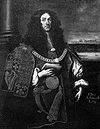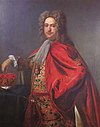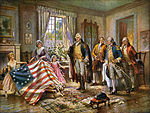Portal:Heraldry/Selected biography archive
May 2006

John Philip Brooke Brooke-Little, CVO, FSA, FHS, (6 April 1927 –13 February 2006) was an influential and popular writer on heraldic subjects and a long-serving officer of arms at the College of Arms in London, England. In 1947, while still a student, Brooke-Little founded the "Society of Heraldic Antiquaries." This organization is now known as The Heraldry Society and is recognized as one of the leading learned societies in its field. He also served as the society's chairman for 50 years until 1997 and then as its President.
(more...)
June 2006

Elias Ashmole was an antiquarian, collector, politician and officer of arms. He supported the royalist side during the English Civil War, and at the restoration of Charles II he was rewarded with several lucrative offices, including Windsor Herald of Arms in Ordinary. Throughout his life he was an avid collector of curiosities and other artifacts. Many of these he acquired from the traveller, botanist, and collector John Tradescant the elder and his son of the same name, and most he donated to Oxford University to create the Ashmolean Museum. He also donated his library and priceless manuscript collection to Oxford. Apart from his collecting activities, Ashmole illustrates the passing of the pre-scientific world view in the seventeenth century: while he immersed himself in alchemical, magical and astrological studies and was consulted on astrological questions by Charles II and his court, these studies were essentially backward-looking. Although he was one of the founding members of the Royal Society, a key institution in the development of experimental science, he never participated actively. (more...)
July 2006

Johannes Baptista Rietstap (12 May 1828–24 December 1891) was a Dutch heraldist and genealogist, who is often considered to be the father of modern heraldry in the Netherlands. Rietstap was proficient in English, French, German, Spanish and Latin in addition to his mother tongue, and from the 1850s to the 1870s published a large number of translations of both fiction and non-fiction works. He also worked as a stenographer for the Staten-Generaal for 37 years, eventually rising to the position of First Stenographer. He is most well-known however for his publication of the Armorial Général. This monumental work contains the blazons of the coats of arms of more than 130,000 European families, and is still one of the most complete works of its kind. (more...)
August 2006
Sir Alexander Colin Cole, KCB, KCVO, (16 May 1922–20 February 2001) was a long serving officer of arms at the College of Arms in London. He eventually rose to the rank of Garter Principal King of Arms, the highest heraldic office in England. Prior to his joining the College of Arms he represented the Manchester Palace of Varieties in the Court of Chivalry for the only case it has tried in the last 200 years. He designed the coat of arms for Margaret Thatcher. (more...)
October 2006

William Camden (May 2, 1551–November 9, 1623) was an English antiquarian and historian. He wrote Britannia, the first topographical survey of the island of Great Britain, and Annales, the first detailed historical account of the reign of Elizabeth I of England. In 1597 he was appointed Clarenceux King of Arms to facilitate his research, the post carrying a salary, and the College of Arms at the time being a centre of antiquarian studies. The appointment, however, roused the jealousy of the herald Ralph Brooke, who in retaliation published an attack on Britannia, charging Camden with inaccuracy and plagiarism. Camden successfully defended himself against the charges in subsequent editions of the work. (more...)
November 2006

Sir John Bernard Burke (January 5, 1814 - December 12, 1892) was a British officer of arms and genealogist. He was born in London, and was educated in London and in France. His father, John Burke (1787-1848), was also a genealogist, and in 1826 issued a Genealogical and Heraldic Dictionary of the Peerage and Baronetage of the United Kingdom. This work, generally known as Burke's Peerage, has been issued annually starting in 1847. While practising as a barrister Bernard Burke assisted his father in his genealogical work, and in 1848 took control of his publications. (more...)
December 2006

Sir John Vanbrugh (pronounced "Van'-bru") (January 24, 1664? – March 26, 1726) was an English dramatist, officer of arms and architect, perhaps best known as the designer of Blenheim Palace. He wrote two argumentative and outspoken Restoration comedies, The Relapse (1696) and The Provoked Wife (1697), which have become enduring stage favourites but originally occasioned much controversy.
Vanbrugh was in many senses a radical throughout his life. As a young man and a committed Whig, he was part of the scheme to overthrow James II, put William III on the throne and protect English parliamentary democracy, dangerous undertakings which landed him in the dreaded Bastille of Paris as a political prisoner. In his career as a playwright, he offended many sections of Restoration and 18th-century society, not only by the sexual explicitness of his plays, but also by their messages in defence of women's rights in marriage. He was attacked on both counts, and was one of the prime targets of Jeremy Collier's Short View of the Immorality and Profaneness of the English Stage. In his architectural career, he created what came to be known as English Baroque. His architectural work was as bold and daring as his early political activism and marriage-themed plays, and jarred conservative opinions on the subject. Vanbrugh also held the heraldic offices of Carlisle Herald and Clarenceux King of Arms. (more...)
February 2007

Sir Anthony Richard Wagner, KCB, KCVO, FSA (6 September 1908–5 May 1995) was a long-serving officer of arms at the College of Arms in London. He served as Garter Principal King of Arms before retiring to the post of Clarenceux King of Arms. He was one of the most prolific authors on subjects of the heraldry and genealogy of the 20th century. (more...)
July 2007

Emilio Aguinaldo y Famy (March 22, 1869 – February 6, 1964) was a Filipino general, politician, and independence leader. He played an instrumental role in Philippine independence during the Philippine Revolution against Spain and the Philippine–American War that resisted American occupation. He designed the flag of the Philippines. (more...)
August 2007

John Anstis (29 August 1669–4 March 1744) was an English officer of arms and antiquarian. He rose to the highest heraldic office in England and became Garter King of Arms in 1718 after years of plotting. Anstis was born at St Neot, Cornwall on 29 August 1669. He was the first son of another John Anstis and his wife Mary, the daughter of George Smith. Anstis matriculated at Exeter College, Oxford, on 27 March 1685 and entered the Middle Temple on 31 January 1690. On 23 June 1695 he married Elizabeth, daughter and heir of Richard Cudlipp of Tavistock, Devon. They had eight sons and six daughters. (more...)
September 2007

Betsy Ross (January 1, 1752 - January 30, 1836) was an American woman who is said to have sewn the first American flag which incorporated stars representing the states of the Union. Born Elizabeth ("Betsy") Griscom in Philadelphia, Pennsylvania, she was the ninth of 17 children of Samuel and Rebecca Griscom, who were members of the Religious Society of Friends (Quakers) (her father was a master builder). She attended Friends (Quaker) schools, where she learned reading, writing, homemaking, and sewing. (more...)
October 2007

James Robinson Planché (February 27, 1796 – May 30, 1880) was a British dramatist, antiquary and officer of arms. Over a period of almost 60 years he wrote, adapted, or collaborated on 176 plays in a wide range of genres. Planché was responsible for introducing historically accurate costume into nineteenth century British theatre, and subsequently became an acknowledged expert on historical costume, publishing a number of works on the topic.
Planché's interest in historical costume led to other antiquarian research, including heraldry and genealogy. He was elected a Fellow of the Society of Antiquaries in 1829, and was influential in the foundation of the British Archaeological Association in 1843. Appointed Rouge Croix Pursuivant in 1854 and promoted to Somerset Herald in 1866, Planché undertook heraldic and ceremonial duties as a member of the College of Arms including proclaiming peace at the end of the Crimean War and investing foreign monarchs with the Order of the Garter. (more...)
